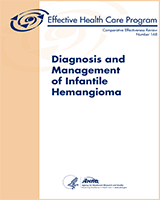From: Results

Diagnosis and Management of Infantile Hemangioma [Internet].
Comparative Effectiveness Reviews, No. 168.
Chinnadurai S, Snyder K, Sathe N, et al.
Rockville (MD): Agency for Healthcare Research and Quality (US); 2016 Jan.
NCBI Bookshelf. A service of the National Library of Medicine, National Institutes of Health.